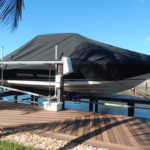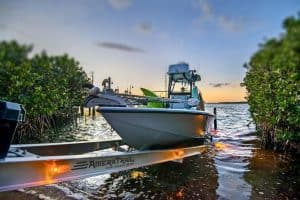Boat lifts have many advantages, from damage prevention to secure storage. Perhaps the biggest benefit of a boat lift is that it can help you keep your boat in better condition for an extended period of time.
In the warmer months, it’s easy to use your boat nearly every day, but what about during the off-season? That’s where boat lifts come in. In this article, I will discuss the most common types of boat lifts and the benefits of each.
The three most common types of boat lifts are:
- Bottom Standing (Freestanding) Lift
- Floating Lift
- Suspended Lift
A bottom standing lift is best for shallow depths, no more than 3 to 10 feet. A floating lift is great for deeper waters and is often a more affordable type of lift. A suspended lift is often used for transporting bigger boats and can be quite expensive.
Read on to learn more about the most common types of boat lifts and their benefits.
Also, we hope you find the links here useful. We may get a commission if you purchase something through a link on this page, so thank you!
3 Most Common Types of Boat Lifts
There are many types of lifts for different types of boats, jet skis, PWCs, pontoons, and other types of watercraft. When choosing what boat lift is right for your boat, you must first determine your boat’s weight and dimensions (including the beam).
To learn about this, see our post: How to Determine Boat Lift Capacity?
You also should be familiar with the area where the lift would need to be installed.
To be safe, you should consider getting a lift that can bear more weight than you really need. The allowance will come in handy when you’re planning on upgrading your boat and adding accessories or gadgets.
With that in mind, here are the 3 main types of boat lifts:
1. Bottom Standing (Freestanding) Lift
Also called a freestanding lift, this is exactly what you need if:
- You have a fixed dock
- You’re dealing with shallow depths, no more than 3 to 10 feet
- You need a lift that will work in bodies of water with silty or powdery floors
Under bottom standing or freestanding lifts, you have the following choices:
- Vertical
- Cantilever
- Pontoon boat
- Shore ramps
- Tritoon
2. Floating Lift
This is the perfect kind of lift when you’re dealing with fluctuating water levels because floating boat lifts can accommodate the rise and fall of the height of the water. The floating lift keeps the boat from pressing down on the structure, keeping potential damage at bay.
There are drive-on floating docks or floating jetski docks to choose from if you’re considering getting a floating lift.
3. Suspended Lift
Otherwise known as hanging cradle boat lifts, these are one of the most hard-wearing options when a permanent, always-covered dock structure is available to you. Cradle kits are an option that can be built into your existing structure or installed in a new steel-framed boat house building.
Suspended lifts often include stainless steel cables, aluminum or galvanized cradles, cable winders, and high-capacity motors all designed for heavy-duty and often maintenance-free use.
There are different kinds of suspended boat lifts and they are the following:
- Boat house
- Pile mount
- Hydraulic
Choosing the Perfect Boat Lift
There are many other factors to take into account when you’re looking to purchase a boat lift. You have to think about what’s most ideal for your boat to make sure you get to enjoy it for a long time to come.
You also have to consider the convenience you get from having your own boat lift, whether or not it’s cost-effective and whether what you have is worth the money and upkeep.
Here are 5 other factors that you have to consider when getting your own boat lift:
- Electric or Manual
- Permits, Rules, and Regulations
- Environment
- Water Height
- High Winds and Water Traffic
1. Electric or Manual
It’s not so much about being a Luddite as it is simply choosing what’s sensible, convenient, and helpful. Manual boat lifts are much more affordable and, in some cases, where electricity can’t be run to docks, it’s the most practical.
It’s operated with a spinner wheel that can be, at times, cumbersome to operate but adds a layer of rustic and old-timey appeal to the process.
Electric boat lifts take a lot more planning and designing before it’s put in place. In the event that electricity can be run to docks, you need to employ a competent and trustworthy electrician who can properly install it and maintain it over time.
With electricity and lights, you can be sure your boat will be waiting for you on the water by the time you’ve unloaded the car or have the lights on as you approach the dock to start the boat.
2. Permits, Rules, and Regulations
Installing electricity on the dock may be allowed, but even then, you will still have a few other things to study and take into consideration. Owning your own boat does not excuse you from having to secure permits and abide by rules and regulations governed by the authorities.
If you live in or near a lakeside or beachside community development, you’re bound to have something that’s known as a community dock. Plainly speaking, homeowners are given a communal multi-slipway dock.
Because a boat lift can sometimes stick out considerably, it can be considered an eyesore by some people, especially when built against a backdrop of houses. And let’s face it, no one wants their view of the water or nature to be blocked by a contraption made of steel, pulleys, and cords.
There might also be some height restrictions in place, so careful planning and creative design will come in handy.
Homeowners Associations have their own set of rules and regulations you need to submit to before you actually buy a boat lift. You may need to consult the committee and get their permission before actually getting it set up or built for you.
3. Environment
Near the top of the list would have to be the water conditions. Keep in mind that metals left in salt will undoubtedly corrode over time. If your dock is built in saltwater, you’ll need to use a boat lift built with something more robust and long-wearing, like galvanized steel or aluminum.
Also, for lifts in saltwater, you may need to use stainless steel cables and framing coated with antifouling paint along with zinc-coated galvanized steel shafts.
4. Water Height
Man-made lakes and like reservoirs tend to have very constant water levels, depending on the weather conditions, of course. Even so, you’re guaranteed to have more than enough time to pull the boat ramp in should the water rise or become choppy.
Even then, the depth of the water, where the front and back part of your boat or the bow and stern will rest, is something you’ll need to seriously consider when choosing the boat lift appropriate for your vessel. From there, you can decide on whether you want a cradle style or swing style boat lift.
A cradle style boat lift helps keep the boat’s hull steady and securely in place.
If you’re working in shallow water, a sling-style boat lift may be a better fit. It will help you get the depth you need to make sure your boat is docked unharmed by the sediment. The sling lies flat horizontally, against the ground, taking up less space.
5. High Winds and Water Traffic
If you live where frequent and often severe storms happen, you will need a boat lift to keep your craft stable. Strong winds will take your raft for a wild ride, especially if you get the occasional hurricane. High winds can potentially cause your boat to ram into the dock, causing massive damage to both your vehicle for water travel and the dock itself.
Sadly, as with a lot of major cities and their wealth of busy thoroughfares, you will also need to take into consideration the surge of boat traffic. If this is the situation, you’ll need to take swing lifts off the table and consider other types of boat lifts.
Look for something more substantially sturdy and solid, something that will keep your vessel steady, avoiding it from being knocked about by the movements around it.
Purchasing a Boat Lift
You’ve finally bought your dream boat, and now, you need a boat lift to keep it safe and secure. Online, you can find a lot of companies who not only build boat lifts but will also be more than happy to give you guidance with your purchase along with the appropriate aftercare you’ll require.
There are also many boat parts that can be found online including:
Boat Lift Motor:
Click here to see it on Amazon.
Boat Lift Sling:
Click here to see it on Amazon.
Boat Lift Switch:
Click here to see it on Amazon.
Boat Lift Jack:
Click here to see it on Amazon.
Make sure to do some research before you proceed and make your comparisons before settling on a boat lift. After all, you dreamt of owning your own boat. You can’t compromise on the lift you’ll use now.
3 Benefits of a Boat Lift
Lastly, let’s look at the 3 benefits of a boat lift. The benefits include protection, time-saving, and convenience.
1. Protection
Left in the water over long periods of time, your boat can get damaged with algae and marine growth. There is also the risk of your boat getting knocked about by wind and waves while it’s tethered to docks. Electrolysis in saltwater can damage your boat if left in the water for too long.
2. Time-saving
Another big benefit of boat lifts is that they are time-saving. If you have your own boat lift, you won’t have to haul your boat to and from the launch ramp to storage. You will also end up saving on fuel costs because you won’t be driving to and from the marina with your boat in tow.
3. Convenience
A third big benefit of having a boat lift is convenience. You’ll end up having more time to enjoy the water if you have easy access to the water. You won’t have to pay for storage or hitch the trailer. You can just easily send off or lower your boat directly from the lift.
Conclusion – Most Common Types of Boat Lifts
To recap, the three most common types of boat lifts are:
- Bottom Standing (Freestanding) Lift
- Suspended Lift
- Floating Lift
If you keep your boat in shallow waters, no more than about 10 feet, I recommend a bottom standing lift. If the water is deeper, I recommend a floating or drive-on boat lift.
Related reading:











![Tri-Hull Boat [What Is It and Its Pros and Cons] tri hull boat](https://boatinggeeks.com/wp-content/uploads/2021/04/tri-hull-boat-150x150.jpg)


